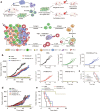Advanced biomaterials for cancer immunotherapy
- PMID: 32123302
- PMCID: PMC7468530
- DOI: 10.1038/s41401-020-0372-z
Advanced biomaterials for cancer immunotherapy
Erratum in
-
Publisher Correction: 10.1038/s41401-020-0400-z,10.1038/s41401-020-0414-6,10.1038/s41401-020-0372-z.Acta Pharmacol Sin. 2021 May;42(5):844. doi: 10.1038/s41401-020-0464-9. Acta Pharmacol Sin. 2021. PMID: 32747717 Free PMC article. No abstract available.
Abstract
Immunotherapy, as a powerful strategy for cancer treatment, has achieved tremendous efficacy in clinical trials. Despite these advancements, there is much to do in terms of enhancing therapeutic benefits and decreasing the side effects of cancer immunotherapy. Advanced nanobiomaterials, including liposomes, polymers, and silica, play a vital role in the codelivery of drugs and immunomodulators. These nanobiomaterial-based delivery systems could effectively promote antitumor immune responses and simultaneously reduce toxic adverse effects. Furthermore, nanobiomaterials may also combine with each other or with traditional drugs via different mechanisms, thus giving rise to more accurate and efficient tumor treatment. Here, an overview of the latest advancement in these nanobiomaterials used for cancer immunotherapy is given, describing outstanding systems, including lipid-based nanoparticles, polymer-based scaffolds or micelles, inorganic nanosystems, and others.
Keywords: cancer; dendritic cells (DCs); hydrogel; immunotherapy; liposomes; micelles; microneedles; nanobiomaterials; nanoparticles.
Conflict of interest statement
The authors declare no competing interests.
Figures








References
-
- Quesada JR, Hersh EM, Manning J, Reuben J, Keating M, Schnipper E, et al. Treatment of hairy cell leukemia with recombinant alpha-interferon. Blood. 1986;68:493–7. - PubMed
-
- Dellacherie MO, Seo BR, Mooney DJ. Macroscale biomaterials strategies for local immunomodulation. Nat Rev Mater. 2019;4:379–97.
-
- Wang C, Ye Y, Hu Q, Bellotti A, Gu Z. Tailoring biomaterials for cancer immunotherapy: emerging trends and future outlook. Adv Mater. 2017;29:29. - PubMed
Publication types
MeSH terms
Substances
LinkOut - more resources
Full Text Sources
Medical

